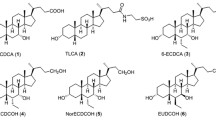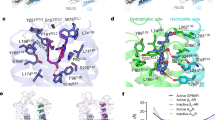Abstract
Formyl-peptide receptors (FPRs) belong to the family A of the G-protein coupled receptor superfamily and include three subtypes: FPR, FPR-like-1 and FPR-like-2. They have been involved in the control of␣many inflammatory processes promoting the recruitment and infiltration of leukocytes in regions of inflammation through the molecular recognition of chemotactic factors. A large number of structurally diverse chemotypes modulate the activity of FPRs. Newly identified antagonists include bile acids deoxycholic acid (DCA) and chenodeoxycholic acid (CDCA). The molecular recognition of these compounds at FPR receptor was computationally investigated using both ligand- and structure-based approaches. Our findings suggest that all antagonists bind at the first third of the seven helical bundles. A closer inspection of bile acid interaction reveals a number of unexploited anchor points in the binding site that may be used to aid the design of new potent and selective bile acids derivatives at FPR.
Similar content being viewed by others
Abbreviations
- GPCR:
-
G protein-coupled receptor
- FPR:
-
formylpeptide receptor
- FPRL-1:
-
formyl peptide receptor like type-1
- FPRL-2:
-
formyl peptide receptor like type-2
- DCA:
-
deoxycholic acid
- CDCA:
-
chenodeoxycholic acid
References
Marasco WA, Phan SH, Krutzsch H, Showell HJ, Feltner DE, Nairn R, Becker EL, Ward PA (1984) J Biol Chem 259:5430
Schiffmann E, Showell HV, Corcoran BA, Ward PA, Smith E, Becker EL (1975) J Immunol 114:1831
Carp H (1982) J Exp Med 155:264
Le Y, Murphy PM, Wang JM (2002) Trends Immunol 23:541
Iribarren P, Zhou Y, Hu J, Le Y, Wang JM (2005) Immunol Res 31:165
Le Y, Yazawa H, Gong W, Yu Z, Ferrans VJ, Murphy PM, Wang JM (2001) J Immunol 166:1448
Walther A, Riehemann K, Gerke V (2000) Mol Cell 5:831
Takano T, Fiore S, Maddox JF, Brady HR, Petasis NA, Serhan CN (1997) J Exp Med 185:1693
Su SB, Gong W, Gao JL, Shen W, Murphy PM, Oppenheim JJ, Wang JM (1999) J Exp Med 189:395
Le Y, Gong W, Tiffany HL, Tumanov A, Nedospasov S, Shen W, Dunlop NM, Gao JL, Murphy PM, Oppenheim JJ, Wang JM (2001) J Neurosci 21:RC123:1
Chen X, Mellon RD, Yang L, Dong H, Oppenheim JJ, Howard OM (2002) Biochem Pharmacol 63:533
Chen X, Yang D, Shen W, Dong HF, Wang JM, Oppenheim JJ, Howard MZ (2000) Inflamm Res 49:744
Wang H, Chen J, Hollister K, Sowers LC, Forman BM (1999) Mol Cell 3:543
Parks DJ, Blanchard SG, Bledsoe RK, Chandra G, Consler TG, Kliewer SA, Stimmel JB, Willson TM, Zavacki AM, Moore DD, Lehmann JM (1999) Science 284:1365
Makishima M, Okamoto AY, Repa JJ, Tu H, Learned RM, Luk A, Hull MV, Lustig KD, Mangelsdorf DJ, Shan B (1999) Science 284:1362
Maruyama T, Miyamoto Y, Nakamura T, Tamai Y, Okada H, Sugiyama E, Nakamura T, Itadani H, Tanaka K (2002) Biochem Biophys Res Commun 298:714
Kawamata Y, Fujii R, Hosoya M, Harada M, Yoshida H, Miwa M, Fukusumi S, Habata Y, Itoh T, Shintani Y, Hinuma S, Fujisawa Y, Fujino M (2003) J Biol Chem 278:9435
Watanabe M, Houten SM, Mataki C, Christoffolete MA, Kim BW, Sato H, Messaddeq N, Harney JW, Ezaki O, Kodama T, Schoonjans K, Bianco AC, Auwerx J (2006) Nature 439:484
Muller G (2003) Drug Discov Today 8:681
Costantino G, Macchiarulo A, Entrena-Guadix A, Camaioni E, Pellicciari R (2003) Bioorg Med Chem Lett 13:1865
Costantino G, Entrena-Guadix A, Macchiarulo A, Gioiello A, Pellicciari R (2005) J Med Chem 48:3251
Edwards BS, Bologa C, Young SM, Balakin KV, Prossnitz ER, Savchuck NP, Sklar LA, Oprea TI (2005) Mol Pharmacol 68:1301
C.C.G. Inc (2005) Molecular operating Environment (MOE)
Schroedinger LLC New York, GLIDE 3.5 (2005)
Schroedinger LLC New York, PHASE 1.0 (2005)
Dalpiaz A, Ferretti ME, Pecoraro R, Fabbri E, Traniello S, Scatturin A, Spisani S (1999) Biochim Biophys Acta 1432:27
Dalpiaz A, Ferretti ME, Vertuani G, Traniello S, Scatturin A, Spisani S (2002) Eur J Pharmacol 436:187
Stenson WF, Mehta J, Spilberg I (1984) Biochem Pharmacol 33:407
Raiden S, Giordano M, Andonegui G, Trevani AS, Lopez DH, Nahmod V, Geffner JR (1997) J Pharmacol Exp Ther 281:624
Levesque L, Gaudreault RC, Marceau F (1991) Can J Physiol Pharmacol 69:419
Kitagawa O, Van der Velde D, Dutta D, Morton M, Takusagawa F, Aubé J (1995) J Am Chem Soc 19:5169
Tran TT, McKie J, Meutermans WD, Bourne GT, Andrews PR, Smythe ML (2005) J Comput Aided Mol Des 19:551
Miettinen HM, Mills JS, Gripentrog JM, Dratz EA, Granger BL, Jesaitis AJ (1997) J Immunol 159:4045
Mills JS, Miettinen HM, Cummings D, Jesaitis AJ (2000) J␣Biol Chem 275:39012
Klco JM, Nikiforovich GV, Baranski TJ (2006) J Biol Chem 281:12010
Perez HD, Vilander L, Andrews WH, Holmes R (1994) J␣Biol Chem 269:22485
Author information
Authors and Affiliations
Corresponding author
Rights and permissions
About this article
Cite this article
Ferrari, C., Macchiarulo, A., Costantino, G. et al. Pharmacophore model for bile acids recognition by the FPR receptor. J Comput Aided Mol Des 20, 295–303 (2006). https://doi.org/10.1007/s10822-006-9055-1
Received:
Accepted:
Published:
Issue Date:
DOI: https://doi.org/10.1007/s10822-006-9055-1




